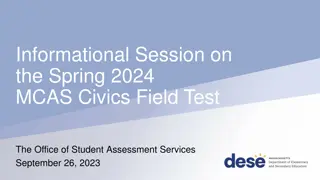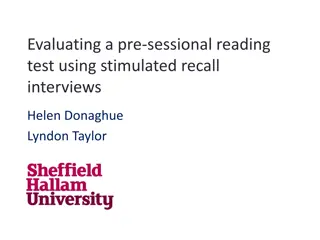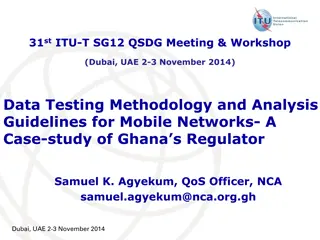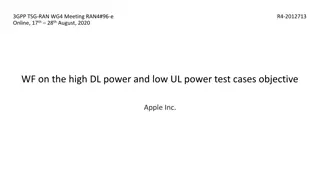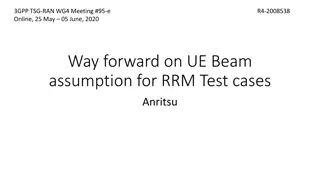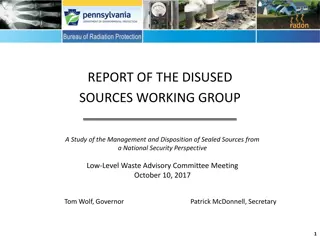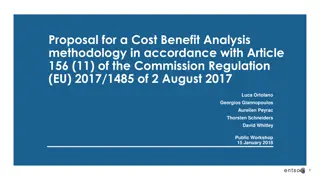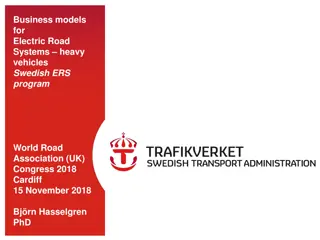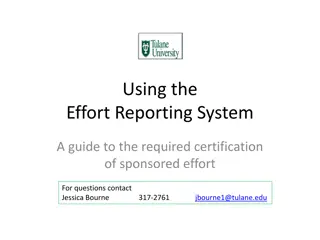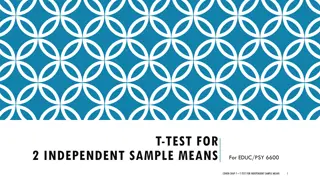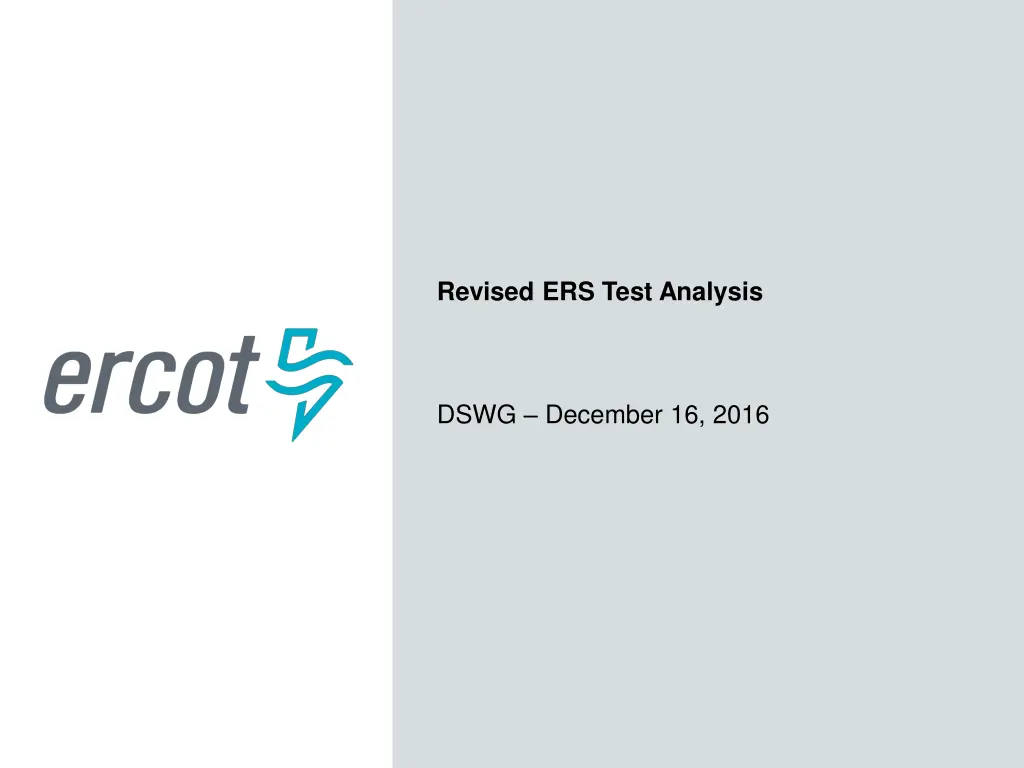
Revised ERS Test Analysis and Default Baseline Options
Explore the revised ERS test analysis conducted by ERCOT in December 2016, alongside the three default baseline methodologies introduced, including insights on protocol references for event/test analysis for emergency response service resources.
Download Presentation

Please find below an Image/Link to download the presentation.
The content on the website is provided AS IS for your information and personal use only. It may not be sold, licensed, or shared on other websites without obtaining consent from the author. If you encounter any issues during the download, it is possible that the publisher has removed the file from their server.
You are allowed to download the files provided on this website for personal or commercial use, subject to the condition that they are used lawfully. All files are the property of their respective owners.
The content on the website is provided AS IS for your information and personal use only. It may not be sold, licensed, or shared on other websites without obtaining consent from the author.
E N D
Presentation Transcript
Revised ERS Test Analysis DSWG December 16, 2016
Default Baseline Options ERCOT has had three default baseline methodologies Regression Middle 8-of-10 Like Days Matching Day Pair Beginning with the October 2016 January 2017 ERS Standard Contract Tem two additional default baselines were introduced Meter Before/Meter After Nearest 20 Like Days ERCOT website link to Default Baseline Methodology for more information on each baseline methodology http://www.ercot.com/services/programs/load/eils/documents 2 PUBLIC
Protocol References for ERS Event/Test Analysis For Resources on the Alternate Baseline, the first partial interval is actually evaluated with a default baseline methodology: 8.1.3.1.4 Event Performance Criteria for Emergency Response Service Resources (3)(ii) For an ERS Load assigned to an alternate baseline, if the IntFrac for the first interval of the Sustained Response Period is less than one, the EIPF for that interval calculated in the formula shown in paragraph (i) above shall use Base_ MWh i derived from historical interval meter data determined by ERCOT to represent an appropriate estimate of the ERS Load s business-as-usual Load specific to the conditions associated with the ERS deployment event. 3 PUBLIC
Protocol References for ERS Event/Test Analysis For all Resources on either an Alternate or Default Baseline, the following section applies: 8.1.3.1.4 Event Performance Criteria for Emergency Response Service Resources (v) Irrespective of its ERSEPF, an ERS Resource shall be deemed to have met its event performance requirements if it is an ERS Load determined by ERCOT to have met its Load reduction obligations in the ERS deployment event if measured on one of ERCOT s established default baseline types other than the baseline type selected by the QSE, and ERCOT determines that the different baseline more accurately represents the ERS Load s Demand response contribution. 4 PUBLIC
Protocol References for ERS Event/Test Analysis For all Resources on either an Alternate or Default Baseline, the following section applies: 8.1.3.2 Testing of Emergency Response Service Resources (1) ERCOT may conduct an unannounced test of any ERS Resource at any time during an ERS Time Period in which the ERS Resource is contracted to provide ERS. Prior to the beginning of a Standard Contract Term, a QSE may request that one or more of its ERS Resources awarded in ERS-30 be tested as if subject to a ten-minute ramp during that ERS Standard Contract Term. The duration of a test will not count toward the ERS Resource s eight hours of maximum deployment time for an ERS Contract Period. (a) For Non-Weather-Sensitive ERS Resources, ERCOT shall determine a test performance factor for each test using the methodology defined in paragraph Section 8.1.3.1.4, Event Performance Criteria for Emergency Response Service Resources. 5 PUBLIC
Events/Tests and Additional Default Baselines ERCOT had to change the test analysis code to incorporate the two new baseline types A description of the new analysis methodology was sent in an email to ERS participants on December 8, 2016 The new methodology incorporates an ERID-like baseline analysis specific to the actual time of the deployment for each Resource to determine which baseline methodology is the most accurate Simulated 2-hour long events spanning the time of the test Simulated events on the same day-type for month before, month of and month after the deployment Except for very large aggregations, baselines are calculated at the site level Baseline and actual interval values are aggregated to the Resource level for each of the default baseline types 6 PUBLIC
Default Baseline Accuracy Evaluation ERCOT had to change the test analysis code to incorporate the two new baseline types (continued) The new methodology incorporates the ERID baseline ranking to identify the best default baselines Goodness-of-fit statistics include R2, MAPE, Bias (Mean Difference), Bias Percent (Mean Percent Difference), 95th Percentile of Mean Difference) Pairwise comparison scores of each of the baselines are calculated for each statistic Baselines with the best scores are ranked provided they meet accuracy thresholds If no baseline meets threshold, only the Alternate baseline is allowed If more than one default baseline are tied with the best ranking score, the baseline with the lowest MAPE is identified as the best baseline for the event/test analysis (note: this may be the same as the baseline specified on the offer) The ranking process may fail to find any sufficiently accurate default baseline 7 PUBLIC
Events/Tests Performance Analysis The performance analysis is done initially using the original baseline specified on the offer If the Resource passes the test/event no further analysis with a different baseline is performed Note: Passing requires event performance factor 0.95 and first full interval performance factor 0.95 If the Resource fails the test/event an analysis using the best default baseline (if any) is performed If event performance factor 0.95 and first full interval performance factor 0.95 the Resource is deemed to have passed the test/event If the Resource fails the test/event on the original baseline and does not pass using the best baseline the Resource is deemed to have failed the test/event 8 PUBLIC
Alternate Baseline - First Partial Interval The first partial interval for a Resource on the alternate baseline is always evaluated with a default baseline methodology Once the protocol language specifying this was adopted, ERCOT exclusively used the Middle 8-of-10 methodology Starting with this Standard Contract Term ERCOT is using the baseline evaluation and ranking approach described in this presentation to determine the baseline to use for the first partial interval If the baseline evaluation and ranking does not identify a best default baseline for the Resource, ERCOT now uses the Nearest 20 Like Days baseline Note: interval performance factors for all full intervals for an Alternate baseline methodology continue to be calculated as ??????? + ????????? ???????? ??????? 9 PUBLIC
Questions? ON OFF 10 PUBLIC

